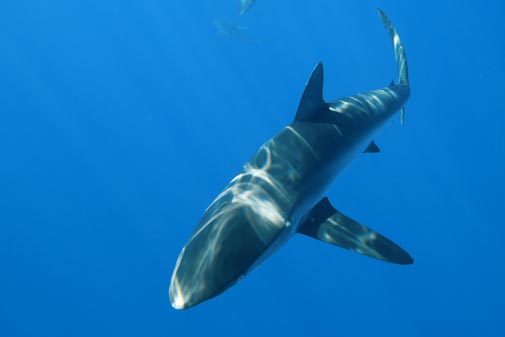For Immediate Release
CONTACT:
Joanna McWilliams
Communications Director
Turtle Island Restoration Network
Cell: (415) 488-7711
joanna@tirn.net
Randall Arauz
International Policy Director
Turtle Island Restoration Network (Costa Rica)
Cell: (506) 8344-3711
rarauz@tirn.net
Silky Sharks Singled Out as Species to Protect at International Conservation Meeting in Hawai’i
Honolulu (September 8, 2016) – This week, participants at an international conservation meeting in Hawaii set a new bar in the conservation of imperiled sharks by overwhelming voting in favor of a resolution to increase protections for silky sharks, a species facing dangerous declines due to industrial fishing practices. The resolution, advanced by Turtle Island Restoration Network, PRETOMA, and Nakawe Project at the International Union for Conservation of Nature (IUCN) World Conservation Congress, received 95 percent favorable votes from participating countries and non-governmental organizations. This advisory resolution is an important building block for next month’s critical Convention on the International Trade in Endangered Species of Wild Fauna and Flora (CITES) meeting later this month in South Africa.
Earlier this week IUCN members to voted overwhelming to pass Resolution 23 to support the conservation and management of silky sharks. The resolution is an important first step in ensuring the survival of silky sharks, a species which is targeted for their valuable fins and is considered to be in need of greater protections.
“I am encouraged that fellow NGOs, scientists and governments overwhelming recognize the need to protect silky sharks on a global scale,” said Randall Arauz, International Policy Director of Turtle Island Restoration Network and 2010 Goldman Environmental Prize Winner. “But to truly protect silky sharks, we need to binding regulations in place, and we can achieve that at the upcoming meeting in South Africa,” he added.
Motions such as the silky shark protection Resolution 23 are proposed by IUCN Members every four years to set priorities for the group as a whole, which is made up of a diverse membership of state and government agencies, NGOs, and networks and thousands of experts. A resolution is a first step in getting global protections for species at the upcoming CITES meeting, which takes place from September 26 – October 6, in Johannesburg, South Africa.
At the CITES meeting, conservationists are supporting a proposal from the Maldives to list the silky shark (Carcharhinus falciformis) under Appendix II of CITES. Listing a species provides it with special protections globally. In the case of the silky shark, fishing nations would need to provide scientific evidence on the sustainability of their extraction for export. If that information is not provided, then the international trade of the species is barred.
Silky sharks are the most common shark caught incidentally by tuna longline and purse seine fisheries throughout their range, particularly those using fish aggregating devices. Silky sharks are the most-caught species in longline fisheries in the Eastern Pacific, constituting up to 90 percent of the total catch of sharks. The species ranks 2nd or 3rd in Hong Kong shark fin markets. Silky sharks are classified as ‘near threatened’ by the International Union for Conservation of Nature (IUCN). In the Central and Eastern Tropical Pacific silky sharks are even more endangered and classified as ’vulnerable.’ Whilst the capture and retention of this species is banned in the Atlantic by the International Commission for the Conservation of Atlantic Tunas (ICCAT), its catches in the Pacific remain unencumbered.
Conservationists are also supporting proposals to list thresher sharks and mobula rays under Appendix II of CITES.
Background Information on CITES & Proposal Support:
Countries that support a silky shark listing under Appendix II: Bahamas, Bangladesh, Benin, Brazil, Burkina Faso, the Comoros, the Dominican Republic, Egypt, the European Union, Fiji, Gabon, Ghana, Guinea, Guinea-Bissau, Maldives, Mauritania, Palau, Panama, Samoa, Senegal, Sri Lanka and Ukraine.
Countries that support a thresher shark listing under Appendix II of CITES: Bahamas, Bangladesh, Benin, Brazil, Burkina Faso, the Comoros, the Dominican Republic, Egypt, the European Union, Fiji, Gabon, Ghana, Guinea, Guinea-Bissau, Kenya, Maldives, Mauritania, Palau, Panama, Samoa, Senegal, Seychelles, Sri Lanka and Ukraine.
Countries that support a mobula ray listing under Appendix II of CITES: Bahamas, Bangladesh, Benin, Brazil, Burkina Faso, the Comoros, Costa Rica, Ecuador, Egypt, the European Union, Fiji, Ghana, Guinea, Guinea-Bissau, Maldives, Mauritania, Palau, Panama, Samoa, Senegal, Seychelles, Sri Lanka and the United States of America.
CITES (the Convention on International Trade in Endangered Species of Wild Fauna and Flora) is an international agreement between governments. Its aim is to ensure that international trade in specimens of wild animals and plants does not threaten their survival. Currently CITES is comprised of 184 members.
For more information about the IUCN Congress visit: http://iucnworldconservationcongress.org/presse/about-iucn-congress
Click here to view Resolution 23: https://seaturtles.org/wp-content/uploads/2016/09/023-Shark-resolution-approved.pdf
###
Turtle Island Restoration Network works to mobilize people and communities around the world to protect marine wildlife, the oceans and the inland waterways that sustain them. Join us on Twitter, Facebook and YouTube. SeaTurtles.org




